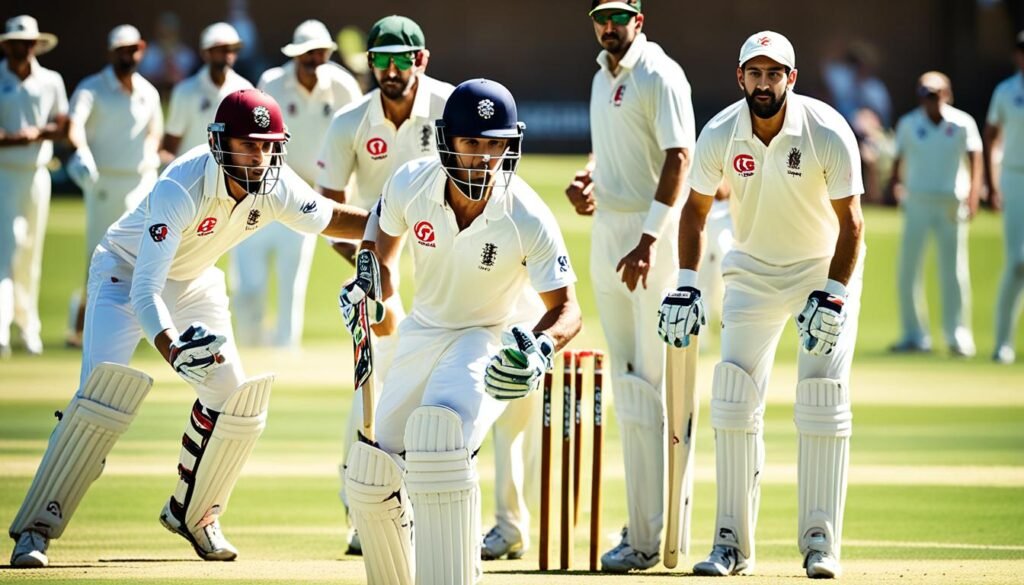How To Plays Cricket is a popular team sport played by millions of people around the world. If you’re new to cricket and want to learn the basics, this guide will provide you with the essential information you need to get started. From understanding the rules and regulations to discovering useful tips and tricks, we’ll cover everything you need to know to enjoy the game of cricket.
Cricket is played between two teams, each consisting of eleven players. The objective of the game is to score more runs than the opposing team. The batting team sends two batsmen onto the field, while the bowling team tries to get them out by hitting the wickets or catching the ball. To score runs, the batsmen can run between the wickets or hit the ball to the boundary. The inning ends when the bowling team has bowled a set number of balls or has gotten 10 of the 11 batsmen out.
Key Takeaways: How To Plays Cricket
- Cricket is a team sport played with a ball, bat, and wickets.
- The objective is to score more runs than the opposing team.
- Batsmen can score runs by running between the wickets or hitting the ball to the boundary.
- An inning ends when the bowling team has bowled a set number of balls or has gotten 10 of the 11 batsmen out.
- Understanding the rules and regulations of cricket is essential to play the game.
Gather Your Team and Equipment
To play cricket, you will first need to gather two teams of eleven players each. It is important to have a sufficient number of players for a proper game and to ensure that each team has an equal number of players.
“Cricket is a team sport that brings together players from different backgrounds and skill levels. By forming two balanced teams, you can create a competitive and enjoyable cricket match.”
Each team will require a few essential pieces of equipment to play the game:
- A Cricket Ball: The cricket ball is a hard, leather-covered ball used for bowling and batting. It is designed to withstand the impact and maintain its shape during the game.
- A Cricket Bat: The cricket bat is a flat, wooden instrument used by the batsman to hit the ball. It consists of a handle, a blade, and a grip. The bat should be of proper size and weight, suitable for the player.
- Wickets: The wickets are wooden structures composed of three vertical sticks driven into the ground. They serve as a target for the bowler to hit and for the fielding team to defend.
Once you have gathered the necessary equipment, you are ready to start playing cricket with your team. Make sure to set up the wickets at a suitable distance from each other and follow the rules and regulations of the game.
With the proper team and equipment, you are now prepared to move on to the next section, where we will discuss the basics of cricket gameplay.
Understanding the Basics of Cricket
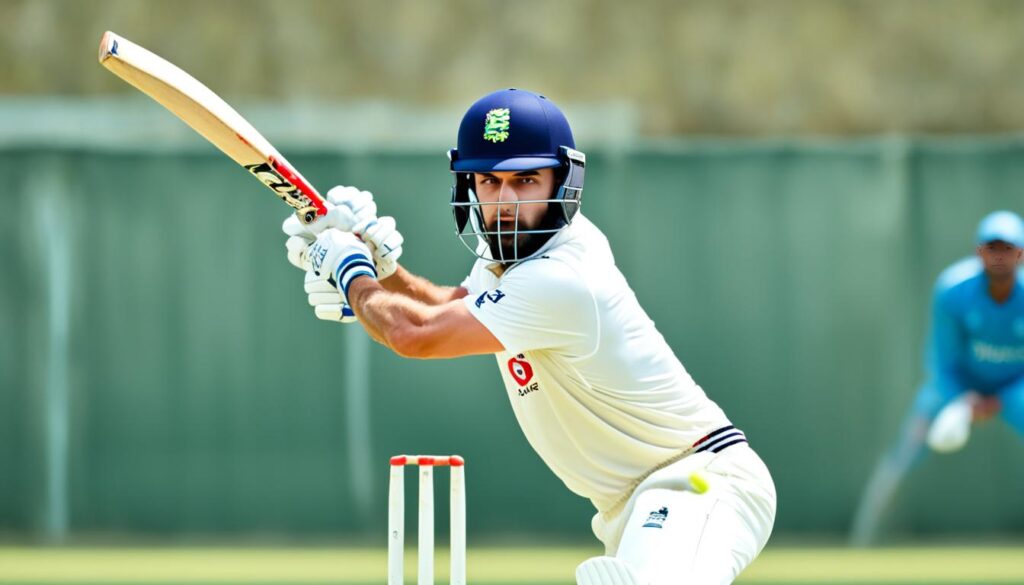
Cricket is a fascinating sport that revolves around two main aspects: batting and bowling. In this section, we will delve into the fundamentals of these two essential elements of the game.
The Role of the Batsman and Bowler
The batsman, representing the batting team, faces the challenge of scoring runs. The bowler, from the fielding team, aims to dismiss the batsman and prevent them from scoring.
During the game, the bowler bowls the ball towards the batsman, who uses their bat to hit it. The batsman’s objective is to score runs by striking the ball and running between the wickets. They can also score boundary runs by hitting the ball to the perimeter of the playing field.
The fielding team, on the other hand, strives to get the batsman out. They can achieve this by hitting the wickets with the ball, catching the ball before it touches the ground, or inducing the batsman to miss the ball and knock down the wickets themselves.
The Concept of Innings and Turns
In cricket, a game is played in innings. Each team takes turns to bat and field. One team bats while the other team fields, and then they switch roles.
During an inning, the batting team aims to score as many runs as possible while the fielding team endeavors to limit their opponent’s scoring opportunities and dismiss their batsmen. Once the inning is over, the teams switch roles, and the team that fielded assumes the batting position.
It is important to note that an inning consists of a set number of overs, with each over comprising six deliveries or balls. The team that scores the highest number of runs by the end of the match wins.
Cricket’s balance between bowlers and batsmen, the art of strategic field placements, and the ability to adapt to various pitch and weather conditions make it a captivating sport for players and spectators alike.
Scoring Runs and Getting Players Out

To score runs in cricket, the batsmen must run between the wickets. Each completed run equals one point. However, there are other ways to score runs as well. If the batsman hits the ball and it reaches the boundary rope, they automatically score four runs. If the ball is hit over the boundary on the full, without touching the ground, it is considered a six, which adds six runs to the batting team’s total.
The fielding team, on the other hand, aims to get the batsman out and prevent them from scoring runs. There are several ways to achieve this. One of the fielders can catch the ball before it hits the ground, resulting in the batsman being dismissed. Additionally, if the fielding team hits the wickets with the ball and knocks off at least one bail, the batsman is out. Another way is if the batsman misses the ball and hits the wickets themselves, causing the bails to dislodge. In all these cases, the batsman is considered to be out, and a new batsman takes their place on the field.
“If a fielder catches the ball before it hits the ground, the batsman is out. It requires skill and quick reflexes to make a successful catch in cricket.” – Cricket Expert
These opportunities for dismissal put pressure on the batsmen to play strategically and avoid making mistakes that could get them out. Similarly, the fielders need to be alert and position themselves tactically to increase their chances of taking catches or hitting the wickets.
Ways to Score Runs and Get Players Out in Cricket
| Scoring Runs | Getting Players Out |
|---|---|
| Running between the wickets | Catch the ball before it hits the ground |
| Ball reaches the boundary (4 runs) | Hitting the wickets with the ball |
| Ball goes over the boundary on the full (6 runs) | Batsman missing the ball and hitting the wickets themselves |
Understanding how to score runs and get players out is essential for players and teams to succeed in cricket. It requires a combination of skill, strategy, and teamwork to achieve favorable outcomes and keep the game competitive and exciting.
The Role of the Umpire

In the game of cricket, the umpire plays a crucial role in ensuring a fair and lawful match. There are usually two umpires on the field who make decisions on the legality of the game, making sure that all players adhere to the rules and regulations. The umpires have the authority to determine whether a delivery is a wide, no-ball, or a legal ball, which affects the outcome of the game.
The umpires also have the responsibility of deciding whether a batsman is out or not. They carefully observe the actions of the bowler, the striker, and the fielders to make fair judgments. Through keen observation, they analyze the skills and techniques displayed by the players and deliver accurate decisions. Their decisions greatly impact the flow of the game and can determine the fate of a team.
Additionally, the umpires are responsible for signaling boundaries when the ball is hit outside the playing area. Boundaries are important in cricket, as they determine the number of runs awarded to the batsman. By signaling boundaries, the umpires ensure that the scoring is accurate and transparent.
Furthermore, while the umpires focus on the overall legality and fairness of the game, there is another player who plays an essential role – the keeper. The keeper stands behind the wicket and acts as the last line of defense for the fielding team. Their primary goal is to catch the ball when the batsman fails to strike it cleanly and to stump the batsman if they venture out of their crease.
| Role | Description |
|---|---|
| Umpire | Makes decisions on the legality of the game, determines whether a delivery is a wide, no-ball, or legal ball, decides whether a batsman is out or not, and signals boundaries |
| Keeper | Stands behind the wicket, catches the ball, and attempts to stump the batsman |
The umpires and the keeper play vital roles in maintaining the integrity and fairness of the game. Their expertise, judgment, and alertness contribute to the smooth and accurate progress of a cricket match. Without them, the game would lack structure and the necessary checks and balances to ensure fair play.
Rules for Innings and Changing Sides
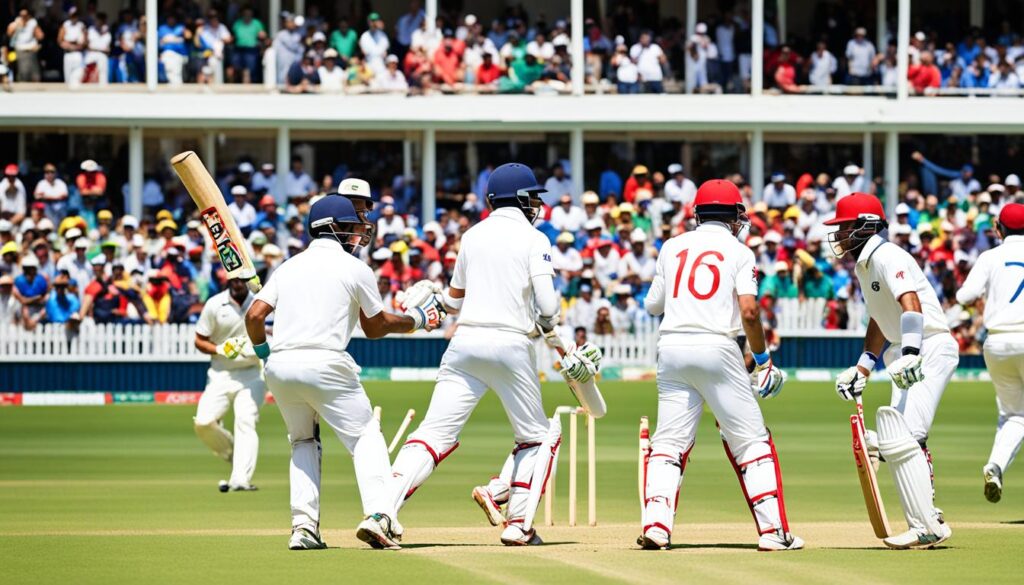
In a cricket match, each team gets one chance to bat and one chance to bowl. The first inning begins with the toss, in which the team that wins the toss decides whether to bat or field first.
The batting team sends two batsmen to the crease, one at each end of the wicket. The non-striker stands at the opposite end of the striker.
The batsmen can score runs by running between the wickets or hitting the ball to the boundary.
The opposing team fields and tries to dismiss the batsmen by taking catches, hitting the wickets, or causing the batsman to miss the ball and hit the wickets themselves.
Inning and Changing Sides Summary:
- Each team gets one inning to bat and one inning to bowl.
- Winning the toss allows the team to decide whether to bat or field first.
- Two batsmen from the batting team stand at each end of the wicket.
- The non-striker stands at the opposite end of the striker.
- Batsmen score runs by running between the wickets or hitting the ball to the boundary.
- The opposing team tries to dismiss the batsman by taking catches or hitting the wickets.
When a Batsman is Out
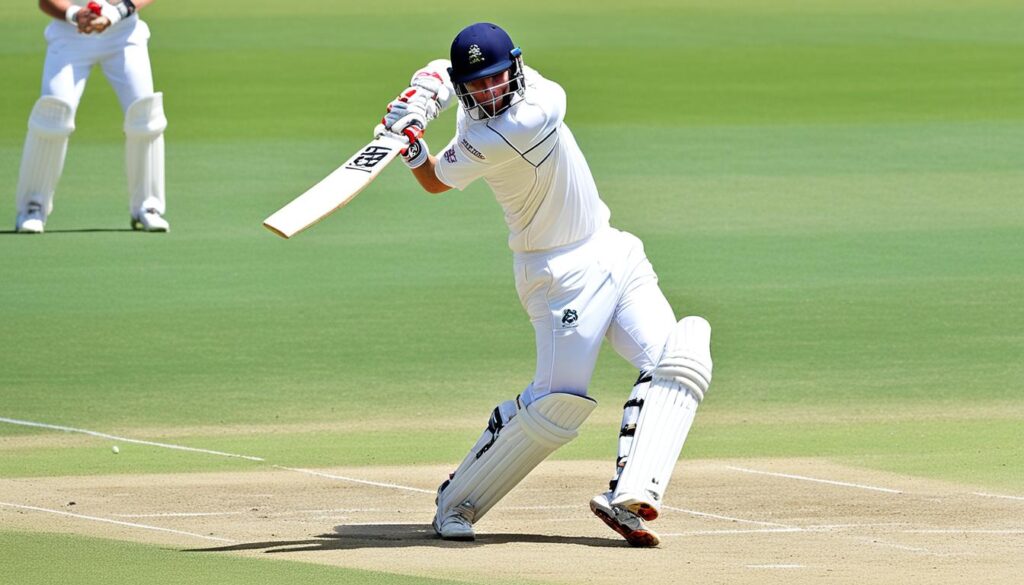
A batsman can be dismissed in several ways. Here are some of the ways a batsman can be declared out:
- If the ball hits the wickets and knocks off at least one bail, the batsman is out. This is known as being “stumped”.
- If the ball is caught by a fielder before hitting the ground, the batsman is out. This is known as being caught.
- If the batsman misses the ball and steps too far forward, and the opposing team knocks down the bails before the batsman can return to the crease, the batsman is out. This is known as being run out.
These are just a few examples, as there are various ways for a batsman to be dismissed in the game of cricket. The specific rules and regulations surrounding dismissals may vary depending on the level of play.
| Dismissal Type | Description |
|---|---|
| Stumped | The ball hits the wickets, knocking off at least one bail. |
| Caught | The ball is caught by a fielder before it hits the ground. |
| Run Out | The batsman misses the ball, steps too far forward, and the opposing team knocks down the bails before the batsman can return to the crease. |
Quote:
“Dismissals in cricket require a combination of skill, precision, and teamwork. The opposing team’s ability to outsmart and outplay the batsman can result in a successful dismissal.”
Switching Roles and Continuing the Game
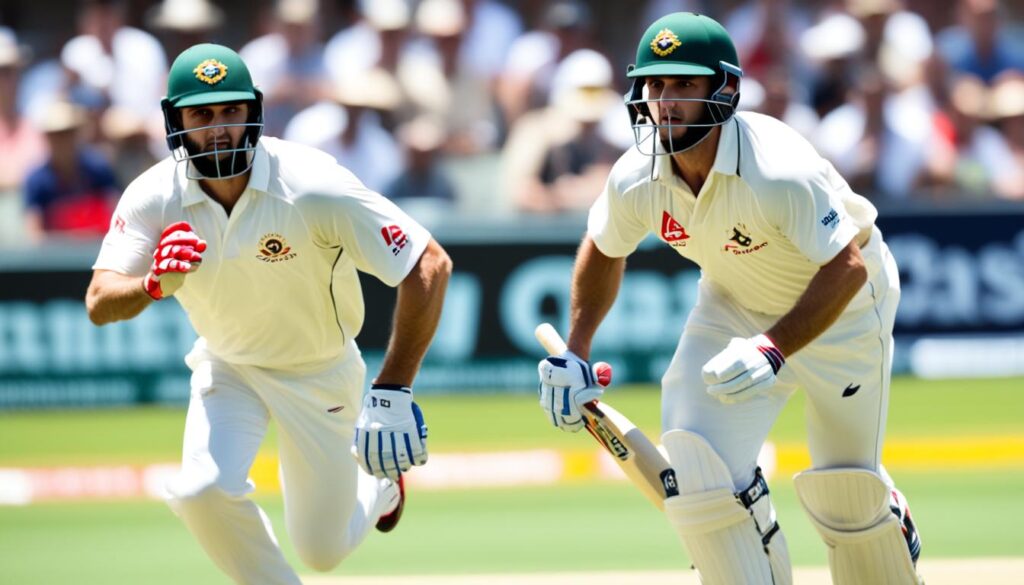
After the first inning, the teams switch roles, with the batting team becoming the fielding team and vice versa. This switch allows both teams the opportunity to experience and showcase their skills in different aspects of the game.
The team that scored the most runs in the first inning has the advantage going into the second inning. Their task is to defend their score and prevent the opposing team from outscoring them. On the other hand, the team that was fielding in the first inning now has the chance to chase the target and try to surpass it to secure victory.
It’s important to note that if the scores are tied at the end of the game, it may end in a draw or go into overtime, depending on the format and rules of the match.
The teams continue to play for a set number of overs, with each over consisting of six balls. This ensures that the game progresses at a steady pace and maintains its competitive nature. The teams strategize to make the most of every ball, whether it’s by taking wickets or scoring runs.
During the game, the ground where the wickets are placed is referred to as “stumps.” This term is commonly used in cricket to describe the area where the bowler aims to hit the wickets and dismiss the batsman.
The ultimate goal for both teams is to outscore their opponents and win the game. With each run scored, the batsmen contribute to their team’s total score. The running batsmen make every effort to cross between the wickets without being dismissed, while the fielding team strives to take wickets and stop the flow of runs.
Now that we’ve explored the role reversal and the continuation of the game, let’s delve into the various formats of cricket and the excitement they bring.
Different Formats of Cricket

Cricket is played in various formats at different levels, catering to different time constraints and objectives. Each format offers its own unique experience and challenges, attracting diverse audiences and players.
One of the popular formats of cricket is Twenty20 (T20). In T20 cricket, each team has the opportunity to bat for 20 overs (a set of six deliveries). This fast-paced format emphasizes aggressive batting, with teams trying to score as many runs as possible within the limited overs. T20 matches are known for their high-energy gameplay and thrilling moments, making them a favorite among spectators.
On the other hand, Test cricket is the longest format of the game, played over a span of five days. Each team gets two innings to bat and bowl. It is a test of endurance, skills, and strategy, as teams aim to outperform their opponents strategically over the course of multiple days. Test cricket is often seen as the pinnacle of the sport, with players demonstrating their technical excellence and mental resilience.
The Cricket World Cup is a prestigious tournament held every four years, bringing together the top international teams to compete for the ultimate prize in the game. Teams from around the world showcase their talent, skill, and teamwork in this highly anticipated event. The Cricket World Cup captivates cricket enthusiasts and showcases the diversity and excellence of the sport on a global stage.
Each format of cricket has its own set of rules, strategies, and fan following. Whether it’s the fast-paced action of T20 cricket, the strategic battles of Test cricket, or the intense competition of the Cricket World Cup, cricket offers something for every fan and player.
Also Read: Learn How to Play Cricket: A Beginner’s Guide
Conclusion
Cricket is a complex and fascinating game that requires a combination of skills, strategic thinking, and teamwork. By mastering the cricket gameplay basics, developing your cricket skills, and incorporating effective cricket strategies, you can truly excel in this sport.
Learning the rules and fundamentals of cricket is the first step towards becoming a proficient player. Understanding how to bowl, bat, and field will not only enhance your individual performance but also contribute to the overall success of your team.
Furthermore, continuous practice and dedication are crucial for your cricket skills development. Regular training sessions, honing your techniques, and improving your physical fitness will gradually elevate your performance on the field.
Lastly, cricket is a strategic game. Analyzing the match situation, making tactical decisions, and effectively communicating and collaborating with your teammates are essential elements of successful cricket strategies. By leveraging these strategies, you can outsmart your opponents and achieve victory.
FAQs
How many players are there in a cricket team?
A: A cricket team consists of 11 players.
Q: What is the role of a wicket keeper in cricket?
A: The wicket keeper is responsible for catching the ball and stumping the batsman.
Q: What is the main objective of a cricket game?
A: The goal of the game of cricket is to score more runs than the opposing team.
Q: What are the three stumps in cricket?
A: The three stumps are the wooden structures placed at each end of the pitch that the bowlers aim to hit.
Q: How is a run scored in cricket?
A: A run is scored when the batsmen run from one end of the pitch to the other after hitting the ball.
Q: What happens at the end of an over in cricket?
A: At the end of an over, the bowling team switches ends and a new bowler starts bowling.
Q: What is the significance of the boundary line in cricket?
A: The boundary line marks the edge of the field, and if the ball is hit past this line, it counts as a boundary or six runs.
